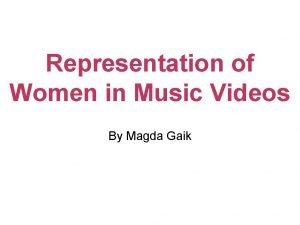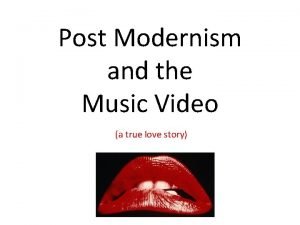Music Videos Theories Sven E Carlsson Music video
















- Slides: 16

Music Videos Theories

Sven E Carlsson Music video is a many-faceted multi-discursive phenomenon. Some generally acknowledged "facts" about music video are that: • music videos communicate through TVscreen and TV-speakers • music videos are a form of low-brow popular culture • the reception of music videos depends on the beholder (music video may be beautiful or ugly, art or trash, etc. ).

Black and White Boxes • Sven E Carlsson said that ‘One of the most common methods of analysis is to break up the music video into black and white boxes. Almost everything is then perceived as opposites – trash or art, commerce or creativity, male or female, naturalism or antirealism, etc. ’ • What is being said is the common approach to music videos in the sense that binary opposites drive the narration of the video forward.


2 Categories Sven E Carlsson believes that there are two categories that music videos are able to fall into: • Performance when the audience are able to see the artist(s) singing and dancing throughout the video. • Conceptual when the audience watch something other than the artist throughout the video.

Performance Clip Performance – this is where the videos mostly focus on the artist/artist’s in some way. There can be three types of performance, Dance performance, Song performance and Instrumental performance. Carlsson argues that the performer fit in to one of three following roles:

1. Commercial Exhibitionist - Modern mythic embodiment This is where the artist sell themselves to get the attention off their audience, and to advertise them self to us. Sven E Carlsson created theory that most performance movies make the performer not a performer any more. “ he or she is a materialization of the commercial exhibitionist. He or she is a monger of their own body image, selling everything to be in the spotlight – selling voice, face, lifestyle, records, and so on” This is saying that performers are restricted in the way that they can perform as they are being used to sell their voice, face, lifestyle etc. Sven E Carlsson says that this is down to the artist being a seller of their body image.


2. Televised Bard • A performance where the singer is singing about a story and uses the images around them as personal images. • The artist tells us a story and we see it happen through there singing with different locations and images.


3. Electronic Shaman • When the artist had magical powers and can be invisible to their soundings • Sometimes the shaman is invisible and it is only her or his voice and rhythm that anchor the visuals. He or she often shifts between multiple shapes and locations.


Michael Shore concludes that music video are recycled styles that contains an information overload and therefore contains views of adolescent male fantasies. Most videos contain elements of speed, power, girls and wealth. All this conveys into soft-core pornography with clichéd imagery. recycled styles … surface without substance … simulated experience … information overload … image and style scavengers … ambivalence … decadence … immediate gratification … vanity and the moment … image assaults and outré folks … the death of content … anesthetization of violence thorough chic … adolescent male fantasies … speed, power, girls and wealth … album art come to turgid life … classical storytelling’s motifs … soft-core pornography … clichéd imagery …

Steve Archer • There needs to be a strong and coherent relationship between narrative and performance in music promos. • Music videos will cut between a narrative and a performance of the song by the band. • A carefully choreographed dance might be part of the artist’s performance or an extra aspect of the video designed to aid visualization and the ‘repeatability’ factor.

John Stewart • The music video has the aesthetics of a TV commercial, with lots of close-ups and lighting being used to focus on the star’s face. • He sees visual reference in music video as coming from a range of sources, although the three most frequent are perhaps cinema, fashion and art photography. • Stewart’s description of the music video as ‘incorporating, raiding and reconstructing’ is essentially the essence of Intertextuality, using something with which the audience may be familiar, to generate both nostalgic associations and new meanings. • The video allows more access to the performer than a stage performance can. The mise-en-scene, in particular, can be used to emphasize an aspirational lifestyle.

Laura Mulvey "In a world ordered by sexual imbalance, pleasure in looking has been split between active/male and passive/female. The determining male gaze projects its fantasy onto the female figure which is styled accordingly” • In a patriarchal society women are passively looked at for the pleasure of men. The representation of women are fantasized by men. Females are seen as objects. • Mulvey argues that the image shown in a music video is planned to the 'narrative'. Mulvey's idea that women are 'dismembered' means that women are not focused on as a whole however the camera tends to focus more on their body parts. She argues that this is due to the fact that women are obsessed with their own body parts. Mulvey also argues that men are the ones seen as a whole.
 Nfv
Nfv Annika carlsson-kanyama
Annika carlsson-kanyama Yngve carlsson
Yngve carlsson Niklas carlsson
Niklas carlsson Hey bye bye
Hey bye bye Music video structure
Music video structure Representation in music videos
Representation in music videos Gender representation in music videos
Gender representation in music videos Digetic meaning
Digetic meaning Representation in music videos
Representation in music videos Conventions of pop music videos
Conventions of pop music videos Backstreet boys video
Backstreet boys video Music videos codes
Music videos codes Representation in music videos
Representation in music videos Music music music
Music music music Video.search.yahoo.com search video
Video.search.yahoo.com search video The frame size of a video refers to the video’s
The frame size of a video refers to the video’s































